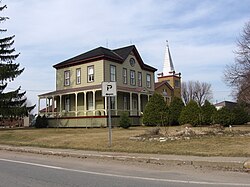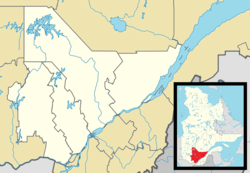
Saint-Tite is a Canadian city located at the foothills of the Laurentians, between Grandes-Piles and Saint-Adelphe, in the Mauricie RCM of Mékinac. A large body of water, Lake Pierre-Paul, bathes the northeastern part of the territory.'
Francheville was a former regional county municipality in the Mauricie region of Quebec, Canada. Prior to its dissolution, it had an area of 1,124 square kilometres (434 sq mi).

Les Chenaux is a regional county municipality in central Quebec, Canada, in the Mauricie region. The seat is in Saint-Luc-de-Vincennes. It is located adjacent on the east of Trois-Rivières on the Saint Lawrence River. It has a land area of 872.04 square kilometres (336.70 sq mi) and a population of 17,865 inhabitants in the Canada 2011 Census. Its largest community is the parish of Notre-Dame-du-Mont-Carmel.
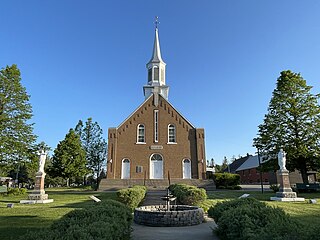
Notre-Dame-du-Mont-Carmel in the Mauricie region of the province of Quebec in Canada.

Sainte-Anne-de-la-Pérade is a municipality in the Les Chenaux Regional County Municipality, in the Mauricie region of the province of Quebec in Canada. The town is located near the mouth of the Sainte-Anne River along the Chemin du Roy, a historic segment of Quebec Route 138 that stretches from near Montreal to Quebec City.
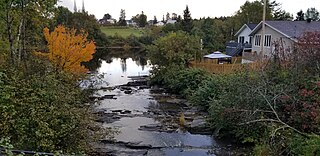
Saint-Adelphe is a Parish municipality of Quebec, Canada, located in the Mékinac Regional County Municipality, in the Batiscanie area and in the administrative region of Mauricie. The territory of the municipality was part of the lordship of Sainte-Anne which was owned by Mr. John Hale, and Mr. Price.

Saint-Prosper-de-Champlain is a municipality of 516 people in the Les Chenaux Regional County Municipality, in Quebec, Canada. It is the smallest municipality in terms of population in the regional county.
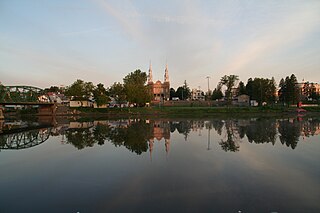
Saint-Stanislas old name Deux-Rivères (Village) is a municipality in Les Chenaux Regional County Municipality in the Mauricie region of the province of Quebec in Canada. It is located along the Batiscan River. The parish is named in honour of St. Stanislaus Kostka to recall the presence of the Jesuits, who were the owners of the lordship of Batiscan.

Saint-Maurice is a parish municipality in the Mauricie region of the province of Quebec in Canada.
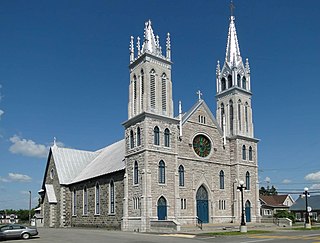
Saint-Narcisse is a parish municipality located in the regional county municipality (MRC) Chenaux, in the administrative region of Mauricie, in the province of Quebec, in Canada. Located on the North Shore of the Saint Lawrence River, about 30 km (19 mi) from downtown Trois-Rivières, the parish of Saint-Narcisse is the heart of the Mauricie region.

Sainte-Geneviève-de-Batiscan is a parish municipality in the Mauricie region of the province of Quebec in Canada. This municipality is part of the Les Chenaux Regional County Municipality in Batiscanie and in the administrative region of Mauricie. It is located along the Batiscan River.

Batiscan is a municipality in the Mauricie region of the province of Quebec in Canada. It is located along the Saint Lawrence River at the mouth of the Batiscan River.

Champlain is a municipality in the province of Quebec, Canada. It is located in Les Chenaux Regional County Municipality and the administrative region the Mauricie, on the north shore of St. Lawrence River. Champlain is also part of the metropolitan area of Trois-Rivières.

The Lordship of Batiscan was located on, and included 1/2 lieue of frontage along, the north shore of the St. Lawrence River in the province of Quebec, Canada. It was 20 lieues deep. Granted in 1639 to the Jesuits, colonization of the manor began in 1666, after an initial allotments were added to the census in 1665.) The northern boundary of the Lordship was past the source of the Saint-Maurice River. It was the deepest in the seigneurial system of New France. The Lordship of Batiscan became the most populous governed area of the Three Rivers by the end of the 17th Century.

The Champlain River flow on the north shore of St. Lawrence river, between Saint-Maurice River and the Batiscan River watershed, in Les Chenaux Regional County Municipality, in Mauricie administrative region, in the province of Quebec, Canada.
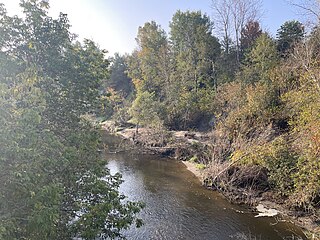
The Charest River takes its source in Charest Lake, in the sector Montauban-les-Mines, in the extreme East of the municipality of Notre-Dame-de-Montauban, located in the Mekinac Regional County Municipality, in the administrative region of Mauricie in the province of Quebec, Canada. In the upper part, Charest River also drains the surrounding lakes: lake of the Mine, lake Perron, lake Perreault and lake End.

The Rivière à la lime flows in the municipality of Sainte-Geneviève-de-Batiscan, in the Les Chenaux Regional County Municipality, in the administrative region of Mauricie, in the province of Quebec, Canada. The "rivière à la lime" drains a watershed of 25.86 km2. This river has a length of 12.14 km and empties into the Batiscan River.

The rivière à la Fourche is a tributary of the northwest bank of the Champlain River, flowing on the east side of the Saint-Maurice River and on the north side of the St. Lawrence River, in the Les Chenaux Regional County Municipality, in the administrative region of Mauricie, in province of Quebec, in Canada.

The Brûlée River is flowing entirely in the municipality of Saint-Maurice, in the Les Chenaux Regional County Municipality, in the administrative region of Mauricie, in Quebec, Canada.

The rivière au Lard flows on 21.2 kilometres (13.2 mi) in the municipality of Notre-Dame-du-Mont-Carmel, then those of Saint-Maurice, Saint-Narcisse and Saint-Luc-de-Vincennes, in the Les Chenaux Regional County Municipality, in the administrative region of Mauricie, in Quebec, in Canada.
